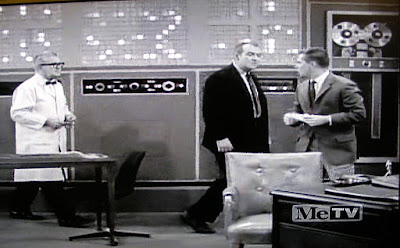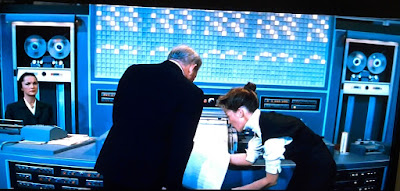PHOTO: An example of the popular portrayal of computers can be seen in this still frame (at about 7 minutes) from the TV show The Many Loves of Dobie Gillis, "Dobie vs. machine" (1961) Season 2, Episode 21 first aired Mar. 14, 1961 (Watched on free 0ver-the-air broadcast KEZI-TV Channel 9.2 5:30-6:00AM Jan. 10, 2016). The TV show's title character Dobie Gillis (right) is holding a computer punch card while standing in front of a $6,000,000 computer that is supposed to use the data on the card to calculate what job Dobie would be best suited for doing after high school based on the "scientific" psychological tests performed by a psychometrician that a high school counselor told Dobie to see because he couldn't figure out what he wanted to do after graduating from high school. The scientists who test Dobie are all dressed white lab coats and they parody the spirt of that era with tests loosely based on real ones. Likewise, the computer is not a real one, but the set and prop designer caricatured the common features of computers in that era, such as magnetic tape drive storage units and flashing lights. In fact, magnetic tape and punched cards were used for input to very expensive mainframe computers that were around when this show was made, but the common portrayal of computers as being infallible brains capable of independently solving problems, while simultaneously waging evil, was laughable both back then and today. (See previous post TV Lesbians in 1961 and grocery delivery rediscovered by Wal-Mart and Amazon (1/9/16) for more on Dobie Gillis.)
It appears that the above Dobie Gillis TV show computer prop and set could have been easily recycled from the one used for some previous Hollywood movies, such as "Desk Set" shown below.
PHOTO: Still frame (at approx. 1:35) from a movie "Desk Set" (1957) (seen on Turner Classic Movie Channel, Comcast Ch. 784, Nov. 26, 2015 5PM PT 103 Minutes) that was made in Germany with aging Hollywood stars. It portrays the fictional IBM EMARAC computer (acronym for Electromagnetic Memory And Research Arithmetical Calculator) that was designed with enough artificial intelligence to do the job of a very skilled Reference librarian named, Ms. Watson, played by Katharine Hepburn, who is shown above examining the line printer's paper output in answer to a question submitted to the computer via a punch card typed up by the IBM computer operator seen to the left. Although the computer's flashing light display is only a fanciful invention of the set designer (who also chose, perhaps not by accident, the IBM blue company color theme) it was based on state-of-the-art IBM computer technology with the full cooperation of IBM, as was prominently mentioned in a credit at the beginning of the film. Even though the tape drive wheels are not turning in a functionally normal fashion, both the tape drive storage and the line printer look like the real ones used back then. Similarly, the small rows of lights and switches on the rack-mounted computer hardware also look like typical 1950's computer hardware. The name of the ace reference librarian character played by Hepburn, "Ms. Watson," was an ironic reference to Thomas Watson Jr. (1914-1993), who was the 2nd president of IBM, 1952-1971, and his father, Thomas J. Watson (1874-1956), who was the chairman and CEO of International Business Machines (IBM) from 1914 to 1956. Today, a more real IBM Watson computer is a a question answering computer system capable of answering questions posed in natural language, which is something this movie envisioned decades ago.
The movie "Desk Set" (1957) appears to be a masterful piece of IBM marketing because it got Hollywood stars, albeit aging ones, to help IBM sell computers by showing IBM's vision of computers being something that would help workers in their job, freeing up their time to do more things, to alleviate the common fears of workers that their jobs would be eliminated due to automation.
Spencer Tracy, Hepburn's costar in "Desk Set" (1957), plays a nerdy engineer and operations efficiency expert who has a blind faith in the ability of a computer to do the job of a reference librarian, which makes Hepburn and her co-workers fear that their jobs will be eliminated by the computer. Their fears are confirmed when everyone is terminated by the payroll department computer (payroll processing was one of the most common applications of IBM computers at the time). Happily, it all turns out to be just a fixable mistake due to human error. The movie uses this and other scenes to promote the ideas that computers are only as perfect as what humans tell them to do, and that a computer will help you do your job, instead of being a threat to it.
I saw "Desk Set" (1957) decades ago and since then I have seen it referenced by numerous books and papers from computer scientists and hardware engineers . I also heard about "Desk Set" from the head of advanced research at Hewlett-Packard, who had worked at IBM before becoming my boss 30 years after this movie was made. He was hired to bring IBM's vision of artificial intelligence research to HP Labs, where many niche applications were developed, but only recently has AI software become more common and profitable for HP.
I also noticed that the movie "Desk Set" (1957) was made in Germany, where IBM had a big operation, and so I wonder if German IBM employees any role in the making of it. Likewise, given that the movie was released around the time that Watson, Sr. died, I wonder if he even knew about it or approved it being made. Clearly, Watson's son was in charge at the time and very likely would have had to approve of it, unless it was a skunk works project by IBM people in Germany who hid from their corporate bosses. In my experience, conservative corporations like IBM would be timid about participating in anything like this with a risk of embarrassment or damage to the company reputation.

